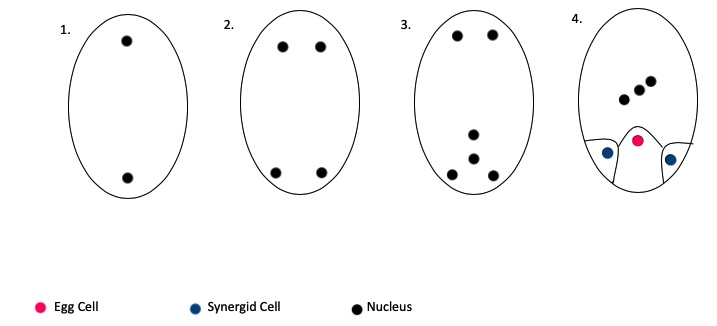
Answer
451.5k+ views
Hint: The female gametophyte in angiosperms contains the antipodal cells, the synergids, polar nuclei and the female gamete. Embryo sac of female gametophytes develops from megaspore which is a mother cell inside the ovule through the processes megasporogenesis and megagametogenesis.
Complete answer:

The female gametophyte in angiosperms develop step by step as follows:-
• At the micropylar end a diploid hypodermal cell differentiates to form archesporium.
• The archesporium functions as the megaspore mother cell.
• The diploid megaspore mother cell undergoes meiosis to form haploid megaspores.
• The fertile megaspore develops into the female gametophyte.
• The nucleus of fertile megaspore undergo three divisions of mitosis.
• This leads to the formation of an eight nucleated structure.
• One nuclei from each pole come to the middle to give the polar nuclei.
• Three cells aggregate at the micropylar end to form the egg apparatus.
• Three antipodal cells at the chalazal end gather together.
This leads to the formation of the female gametophyte or the embryo sac in angiosperms, and this process is called megagametogenesis.
Note: It is to be noted that, only one megaspore is involved in the formation of one embryo sac. This is the most common form of development and is known as the monosporic form. However in certain cases, bisporic and tetrasporic development of angiosperms have also been found where two or four embryo sacs develop from the megaspore of flowering plants.The formation of the female gametophyte is an extremely important process for the sexual reproduction in flowering plants.
Complete answer:

The female gametophyte in angiosperms develop step by step as follows:-
• At the micropylar end a diploid hypodermal cell differentiates to form archesporium.
• The archesporium functions as the megaspore mother cell.
• The diploid megaspore mother cell undergoes meiosis to form haploid megaspores.
• The fertile megaspore develops into the female gametophyte.
• The nucleus of fertile megaspore undergo three divisions of mitosis.
• This leads to the formation of an eight nucleated structure.
• One nuclei from each pole come to the middle to give the polar nuclei.
• Three cells aggregate at the micropylar end to form the egg apparatus.
• Three antipodal cells at the chalazal end gather together.
This leads to the formation of the female gametophyte or the embryo sac in angiosperms, and this process is called megagametogenesis.
Note: It is to be noted that, only one megaspore is involved in the formation of one embryo sac. This is the most common form of development and is known as the monosporic form. However in certain cases, bisporic and tetrasporic development of angiosperms have also been found where two or four embryo sacs develop from the megaspore of flowering plants.The formation of the female gametophyte is an extremely important process for the sexual reproduction in flowering plants.
Recently Updated Pages
Write the IUPAC name of the given compound class 11 chemistry CBSE

Write the IUPAC name of the given compound class 11 chemistry CBSE

Write the IUPAC name of the given compound class 11 chemistry CBSE

Write the IUPAC name of the given compound class 11 chemistry CBSE

Write the IUPAC name of the given compound class 11 chemistry CBSE

Write the IUPAC name of the given compound class 11 chemistry CBSE

Trending doubts
Fill the blanks with the suitable prepositions 1 The class 9 english CBSE

How do you graph the function fx 4x class 9 maths CBSE

Which are the Top 10 Largest Countries of the World?

Which is the longest day and shortest night in the class 11 sst CBSE

What is the definite integral of zero a constant b class 12 maths CBSE

Name five important trees found in the tropical evergreen class 10 social studies CBSE

The Equation xxx + 2 is Satisfied when x is Equal to Class 10 Maths

Differentiate between homogeneous and heterogeneous class 12 chemistry CBSE

Difference between Prokaryotic cell and Eukaryotic class 11 biology CBSE




